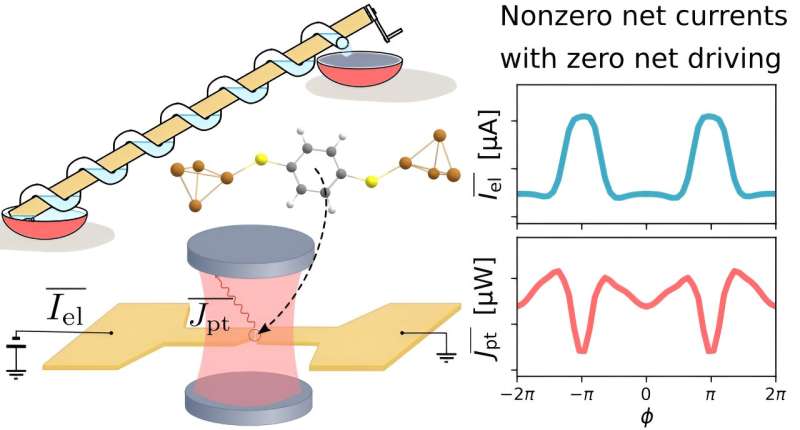
Researchers have developed a new theoretical modeling technique that could potentially be used in the development of switches or amplifiers in molecular electronics. The modeling technique is a collaboration between researchers at the University of Jyväskylä, Finland, and Wroclaw University of Science and Technology, Poland.
The paper is published in the journal Nano Letters.
Molecular electronics is the study of how electrons move in junctions formed by individual molecules and how this can be used in electronic devices. The time scales of the theoretical models typically used in these processes are very fast compared to those observed experimentally and aligning them has been a challenge.
Using a new modeling technique developed by researchers at the University of Jyväskylä and Wroclaw University of Science and Technology, a setup was investigated in which a benzenedithiol molecule is coupled to copper electrodes and interacts with light in a cavity. The new theoretical method provides an experimentally relevant time scale for the study of molecular junctions.
“Our theoretical results show that the molecular system we studied can produce significant light emission and high harmonic generation,” says Senior Lecturer Riku Tuovinen from the University of Jyväskylä.
Interestingly, the way these effects occur is more akin to what has been observed in solid state materials rather than in atomic or molecular systems.
“The study also found that symmetries in the configuration can either suppress or enhance certain light frequencies,” says Tuovinen, “so the configuration could potentially be used as a switch or amplifier in molecular electronics.”
The researchers refer to the studied setting as a kind of molecular quantum pump.
“Similar to how the efficiency of the famous Archimedes’ screw depends on the tilting angle and the spiral step, the efficiency of molecular quantum pumps depends on the magnitude and phase difference of the driving voltages,” explains Tuovinen.
More information:
Riku Tuovinen et al, Electroluminescence Rectification and High Harmonic Generation in Molecular Junctions, Nano Letters (2024). DOI: 10.1021/acs.nanolett.4c02609
Citation:
Quantum pumping in molecular junctions: Theoretical model could lead to switches and amplifiers (2024, August 15)
retrieved 15 August 2024
from https://phys.org/news/2024-08-quantum-molecular-junctions-theoretical-amplifiers.html
This document is subject to copyright. Apart from any fair dealing for the purpose of private study or research, no
part may be reproduced without the written permission. The content is provided for information purposes only.







